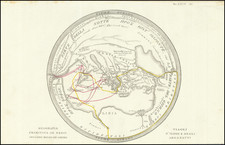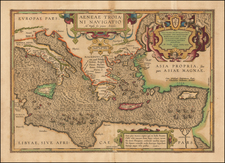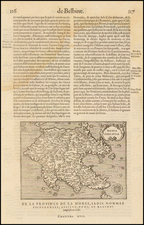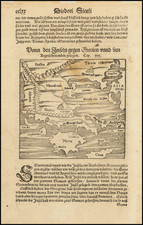Celebrating the Ventian Conquest of Preveza
Fine early map of Preveza Bay on the west coast of Greece, published in Venice by Coronelli.
The map was likely published to commemorate the conquest of Preveza and environs by the Venetians from the Ottoman Empire in 1684.
The map shows the Ambracian Gulf, including the town of Preveza, and part of Lefkada. Fine inset of the fortress city of Prevesa guarding the inlet.
Includes a large figurative cartouche with crest and weapons.
Preveza
The Ottomans refounded Preveza in about 1477, with a subsequent strengthening of the fortifications in 1495. The naval Battle of Preveza was fought off the shores of Preveza on in September 1538, where the Ottoman fleet of Hayreddin Barbarossa defeated a united Christian fleet under the Genoese captain Andrea Doria. This day is a Turkish Navy National Holiday, and some of today Turkish submarines called "Preveze".
Preveza was hotly contested in several Ottoman-Venetian Wars. In September 1684, at the early part of the Morean War, the Venetians, aided by the Greeks, crossed from the island of Lefkada (Santa Maura) and captured Preveza as well as Vonitsa, which gave them control of Acarnania – an important morale booster towards the main campaign in the Morea. However, at the end of the war in 1699 Preveza was handed back to Ottoman rule.
Venice would capture Preveza again in 1717, during its next war with the Ottomans and was this time able to hold on to the town and fort. Venetian rule would persist until the very end of the Venetian Republic itself in 1797.
Vincenzo Maria Coronelli (1650-1718) was one of the most influential Italian mapmakers and was known especially for his globes and atlases. The son of a tailor, Vincenzo was apprenticed to a xylographer (a wood block engraver) at a young age. At fifteen he became a novice in a Franciscan monastery. At sixteen he published his first book, the first of 140 publications he would write in his lifetime. The order recognized his intellectual ability and saw him educated in Venice and Rome. He earned a doctorate in theology, but also studied astronomy. By the late 1670s, he was working on geography and was commissioned to create a set of globes for the Duke of Parma. These globes were five feet in diameter. The Parma globes led to Coronelli being named theologian to the Duke and receiving a bigger commission, this one from Louis XIV of France. Coronelli moved to Paris for two years to construct the King’s huge globes, which are 12.5 feet in diameter and weigh 2 tons.
The globes for the French King led to a craze for Coronelli’s work and he traveled Europe making globes for the ultra-elite. By 1705, he had returned to Venice. There, he founded the first geographical society, the Accademia Cosmografica degli Argonauti and was named Cosmographer of the Republic of Venice. He died in 1718.









![The Bay of Corve [with] The Bay of Zea](https://storage.googleapis.com/raremaps/img/small/62959op.jpg)



![Candia [with] Corfu [with] Zante [with] Mion [with] Nicsia [with Scarpanto](https://storage.googleapis.com/raremaps/img/small/46356.jpg)
